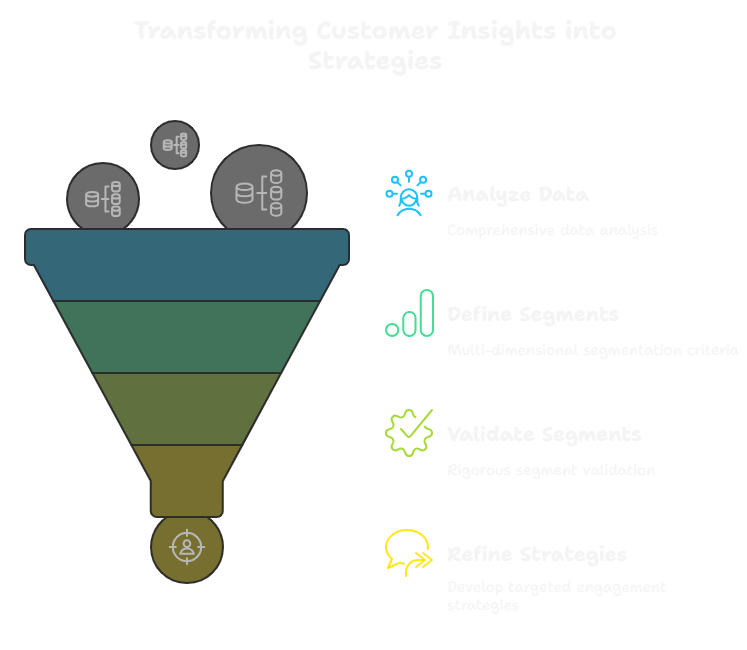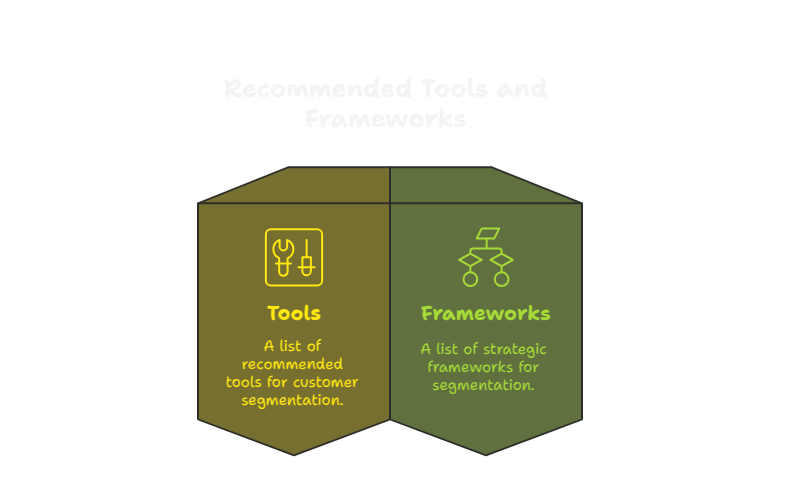Building Customer Segments for GTM: A Strategic Framework
Have you ever wondered why some B2B companies hit their market targets with precision while others miss the mark completely? Recent research reveals that organizations with sophisticated customer segmentation strategies are 60% more likely to exceed their revenue goals.
Market research professionals know the critical challenge: developing customer segments that move beyond basic demographics to reveal genuine behavioral insights. Traditional approaches frequently fall short, creating fragmented views that dilute marketing effectiveness and lead to inefficient resource allocation.
The consequences are stark—missed opportunities, misaligned messaging, and diminishing returns on go-to-market investments. What separates top-performing organizations isn't just data collection, but the ability to transform complex customer information into actionable, strategic segments that drive meaningful engagement and sustainable growth.
Understanding Customer Segmentation for Go-to-Market Strategy
Customer segmentation is a strategic approach of dividing a broad customer base into distinct groups with shared characteristics, behaviors, and potential business value. At its core, it transforms a complex market landscape into manageable, targeted clusters that enable more precise marketing, sales, and product development efforts.
For B2B professionals, effective customer segmentation goes beyond simple demographic categorization. It involves a multi-dimensional analysis that considers:
- Firmographic data (company size, industry, revenue)
- Behavioral patterns and engagement metrics
- Specific pain points and strategic challenges
- Potential lifetime value and growth potential
The strategic importance of robust customer segmentation cannot be overstated. By developing nuanced segments, organizations can:
- Customize communication and messaging
- Optimize resource allocation
- Design targeted value propositions
- Predict and anticipate customer needs more accurately
Successful B2B companies recognize that one-size-fits-all approaches are obsolete. Precision in understanding customer segments translates directly into competitive advantage, enabling more intelligent, responsive go-to-market strategies that resonate with specific audience needs.
Why Customer Segmentation Matters for Your Business
In the complex world of B2B marketing, customer segmentation isn't a luxury—it's a strategic necessity. For small and medium-sized businesses competing against industry giants, precise customer insights become the ultimate competitive differentiator.
Critical Business Benefits
-
Enhanced Market Penetration
By understanding distinct customer clusters, businesses can target specific market niches with unprecedented precision, reducing customer acquisition costs and increasing conversion rates.
-
Improved Product-Market Fit
Granular segmentation enables product development teams to design solutions that directly address unique customer challenges, leading to higher satisfaction and retention rates.
-
Strategic Resource Allocation
Targeted segments allow marketing and sales teams to prioritize high-potential customer groups, optimizing budget spend and maximizing return on investment.
-
Predictive Business Intelligence
Advanced segmentation provides early signals about emerging market trends, allowing businesses to proactively adapt their strategies before competitors.
Common Segmentation Pitfalls to Avoid
Despite its potential, many businesses stumble when developing customer segments:
- Relying exclusively on surface-level demographic data
- Creating too many segments, leading to fragmentation
- Failing to regularly update and refine segmentation models
- Ignoring behavioral and intent-based signals
Effective segmentation requires continuous refinement and a commitment to understanding the evolving needs of your target market. By embracing a dynamic, data-driven approach, businesses can transform customer insights into sustainable competitive advantages.
A Strategic Framework for Building Effective Customer Segments

Transforming customer insights into actionable market strategies requires a systematic, data-driven approach. The following framework provides B2B professionals with a comprehensive method for developing precise customer segments.
Step 1: Data Collection and Comprehensive Analysis
The foundation of effective segmentation begins with robust data gathering:
- Data Sources:
- CRM systems
- Customer interaction logs
- Sales engagement records
- Third-party market research
Pro Tip: Integrate both quantitative and qualitative data sources to create a holistic customer view.
Common Pitfall: Relying solely on internal data, which can create blind spots in customer understanding.
Step 2: Develop Multi-Dimensional Segmentation Criteria
Move beyond traditional demographic segmentation by incorporating multiple dimensions:
- Segmentation Dimensions:
- Firmographic characteristics
- Behavioral patterns
- Technology adoption levels
- Strategic business objectives
- Purchasing behavior and decision-making processes
Pro Tip: Use advanced analytics tools to identify correlation patterns across different customer attributes.
Common Pitfall: Creating too many segments that become unmanageable and dilute strategic focus.
Step 3: Validate and Refine Segment Definitions
Ensure segment accuracy through rigorous validation:
- Validation Techniques:
- Cross-functional team review
- Statistical significance testing
- Pilot marketing campaigns
- Continuous performance monitoring
Pro Tip: Implement a quarterly review process to keep segments dynamic and responsive to market changes.
Common Pitfall: Treating segmentation as a one-time exercise instead of an ongoing strategic process.
Step 4: Develop Targeted Engagement Strategies
Transform segment insights into actionable go-to-market approaches:
- Engagement Optimization:
- Customize communication channels
- Design segment-specific value propositions
- Create tailored content and messaging
- Align sales and marketing approaches
Pro Tip: Leverage AI and machine learning tools to personalize segment interactions at scale.
Common Pitfall: Generic messaging that fails to address specific segment needs and pain points.
Tools and Frameworks for Advanced Customer Segmentation

Transforming customer segmentation insights into actionable strategies requires sophisticated tools and proven frameworks. The right combination of technology and methodology can dramatically enhance your go-to-market precision.
Recommended Tools for Customer Segmentation
-
Segment
A powerful customer data platform that consolidates information from multiple sources, enabling comprehensive customer profile creation and real-time segmentation analysis.
-
Salesforce Marketing Cloud
Advanced segmentation capabilities with AI-driven insights that help businesses create dynamic, behavior-based customer clusters and personalized engagement strategies.
-
Heap Analytics
Automatically captures user interaction data, providing granular insights into customer behaviors and enabling more nuanced segmentation strategies.
-
HubSpot Customer Segmentation Tools
Integrated platform offering comprehensive segmentation capabilities with easy-to-use interfaces for B2B marketing and sales teams.
-
Google Analytics Advanced Segments
Free tool for creating sophisticated customer segments based on demographics, behavior, and custom dimensions.
Strategic Segmentation Frameworks
-
RFM (Recency, Frequency, Monetary) Framework
A classic segmentation approach that categorizes customers based on their purchasing behavior, helping businesses identify high-value and at-risk customer groups.
-
Jobs-to-be-Done (JTBD) Framework
Focuses on understanding customer segments through the lens of their specific business challenges and desired outcomes, enabling more precise value proposition development.
-
Technographic Segmentation Model
Categorizes customers based on their technology adoption levels, providing insights into potential product positioning and marketing strategies.
-
Value-Based Segmentation Framework
Segments customers according to their potential lifetime value, allowing businesses to prioritize and customize engagement strategies.
Pro Tip: No single tool or framework is a silver bullet. The most effective approach combines multiple tools, frameworks, and continuous refinement.
Common Pitfall: Relying exclusively on out-of-the-box solutions without customizing them to your specific business context.
Conclusion: Transforming Customer Segmentation into Strategic Advantage
Building effective customer segments is not merely a tactical exercise but a strategic imperative for modern B2B organizations seeking competitive differentiation. By integrating advanced data analytics, behavioral insights, and sophisticated segmentation methodologies, market research professionals can create nuanced customer profiles that transcend traditional demographic boundaries. The key lies in continuous refinement, leveraging machine learning algorithms, and maintaining a dynamic approach that adapts to evolving market landscapes. As customer expectations become increasingly complex, those who master granular segmentation techniques will not only optimize their go-to-market strategies but fundamentally transform how businesses understand, engage, and deliver value to their target audiences. Remember, successful customer segmentation is a journey of perpetual learning, where each iteration brings you closer to unparalleled market precision and customer-centric innovation.
